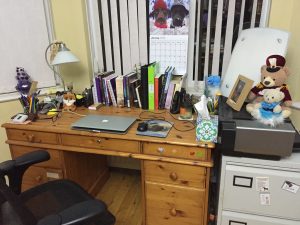 The idea for a post entitled Organised Chaos arose when somebody asked me a question a few days ago about how I organise my research when I’m writing a new book. I gave, what was for me, quite a sensible answer. Thinking about it afterwards, I realised that I actually do have a system for this. Many other areas in my life bumble along without much of a plan, but when it comes to writing, I’ve learned what works and I stick to it.
The idea for a post entitled Organised Chaos arose when somebody asked me a question a few days ago about how I organise my research when I’m writing a new book. I gave, what was for me, quite a sensible answer. Thinking about it afterwards, I realised that I actually do have a system for this. Many other areas in my life bumble along without much of a plan, but when it comes to writing, I’ve learned what works and I stick to it.

I’m not sure if my system would work for anybody else, but I know that I quite like reading other people’s ideas about organisation, so I thought I’d share the tools I use, in case any of them come in handy for other people. At the very least, you can all have a good laugh at them.
My writing life is very complicated, and every time it threatens to get easier, I find new ways to complicate it further. I’ve published eleven historical novels so far. The earliest two were standalone books but all of the others are linked in some way, although I’ve written them at different times and they are all set at different points of my timeline. So, the Peninsular War Saga begins in 1802 and I’ve published five books, taking me to the end of 1812 and I’m now working on book six. The Manxman series has two books so far and begins in 1806 with the second one taking us into 1810. The two Regency romances are set in 1816 and 1818. In addition, I’ve written eight short stories, all of which are linked to the main books and run from around 1809 through to Waterloo in 1815.
Characters move regularly between the different series. Because I had already published the first four Peninsular books and the two Regencies before I started the Manxman series, I’m not writing the books consecutively. This means that I need to constantly be aware of what my characters do or don’t already know and whom they might have met at a different part of the timeline. I’m time hopping every time I start a new book, which means I need to keep very good records of my characters, even the minor ones. Before I had set up a good system, I discovered during editing that several soldiers who died at Assaye or Talavera were up and fighting again at Bussaco, it was like an episode of the Walking Dead.
A good example of the challenge of this is Giles Fenwick. I first wrote about Giles in one of the Regency romances, where in true romantic hero style, he is a cynical war veteran, emotionally shut down and struggling with what we would call PTSD today. He’s also an Earl. There is a brief mention of his wartime service, where he spent part of his time as an exploring officer.
I then decided to use him in a short story set during the war, and also to introduce him as a minor character into the Peninsular War Saga. From there, I was writing about Walcheren in the second Manxman book and realised that I’d mentioned somewhere that Giles had been there, so introduced him as one of my main characters. Now I’ve moved back to the Peninsula, I’ve given him a bigger role there, but need to remember that Walcheren, although it was the last book I wrote, was four years ago for Giles. Is anybody else confused yet?
I use several tools to keep on top of my characters and my research.
Character List Spreadsheet
This one speaks for itself, really. I use Excel and when I’m editing, I check every single character against this list and add any new information. It has columns for all the basic information such as name, age, physical appearance if I’ve mentioned it, family relationships etc. Then there is a notes column where I can not any significant role the character has played in the book. I don’t use this much for the main characters, since I know what they’ve been up to, but it’s useful to remember, for example, that Private Thompson sometimes acted as orderly and valet to Colonel Wheeler, because it means I’ll be consistent about that. A very important column is headed ‘Death’ and I record the date and how they died. This avoids any zombie resurrections, which is always what we want. I keep a single list for all the books, since the characters move between them.
Book Folder
For each book I’ve written or am about to write, I create a book folder. Everything associated with this book, is stored in the one place, including the book itself, the blurb, the online source folder, book covers, pictures I might like to use on the web page for the book and an ideas folder.
Online Source Folder
In the early days, I used to bookmark really useful sources which are available online, but I found that I was losing track of what I’d found. I might remember reading something about promotion without purchase, but couldn’t remember where. These days, I create a new research folder every time I start a new book and keep it in the same place as my Scrivener files, and I’ll store links to good online resources relevant to this book all in the same place, under headings that make sense to me. It saves a lot of time searching online for something I’ve already found.
Ideas Folder
Every book in the series has a provisional title, even those I’ve not yet written. I might change that when I come to write it, in fact my current work in progress has just been changed from an Unrelenting Enmity to An Unmerciful Incursion to reflect the change in emphasis of the storyline. This means that if I have a sudden idea while writing one book, that I might like to use in a future book, I can make some notes and store them in the folder.
Notebook
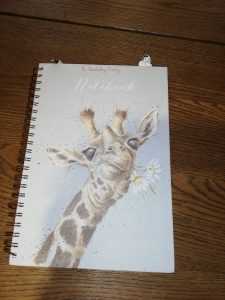 When it comes to the day to day planning for a book, I have to use an old fashioned notebook. Scrivener, which I write with, has the facility to store research and planning notes, and I tried it. I’ve also tried other software such as Aeon, for doing timelines. None of these worked for me. While I’m typing, I much prefer to reach for a book than have endless tabs open on a screen, it just works better.
When it comes to the day to day planning for a book, I have to use an old fashioned notebook. Scrivener, which I write with, has the facility to store research and planning notes, and I tried it. I’ve also tried other software such as Aeon, for doing timelines. None of these worked for me. While I’m typing, I much prefer to reach for a book than have endless tabs open on a screen, it just works better.
It’s also an excuse to use a selection of lovely notebooks. A plain A4 pad would work perfectly well, but of course I don’t use that. As you’ll see from my current notebook, I work best with cute animals, but I’m flexible.
In my notebook, I keep a detailed timeline, almost a diary, of what happened during the period I’m writing about, with quick references to books if I found something particularly useful. I leave a lot of space between dates. Once I’ve got the historical timeline worked out, I’ll go back as I’m writing, and slot in my fictional characters, so that I can weave my own story into the fabric of the historical events. It’s a bit like a diary, and it can change the direction of the book if I find out something interesting while I’m putting this together.
A good example of this is the shipwreck of the Venerable in 1809 off the coast of Walcheren. I first learned about this from the autobiography of Dr McGrigor, who was on the ship, and I slotted it into the timeline, and read about it. It occurred to me that it might be interesting to mention this in the novel, but I wanted to know a bit more about it. McGrigor mentioned two ladies aboard as well as some soldiers wives below decks, and I went through the sources I was using to try to find out more. In the bibliography of a thesis I’d been using, I came across a reference to the diaries and letters of Captain Codrington, whose wife was one of the ladies on the ship. These were available online and were pure gold. I also realised, to my surprise, that it gave me the opportunity to give a much bigger role to the heroine of my previous book as it was a way of bringing her out to join her husband along with Jane Codrington.
In addition, reading the Codrington letters, which were fairly addictive, gave me an idea for a future book in the Manxman series, which immediately went into the ideas folder. The Venerable shipwreck was added into my timeline along with a lot of useful information gleaned from a friend who was doing research on Sir Home Popham and was able to send me photos of the original logs of the ship during this period along with a huge amount of other useful information.
Along with the timeline, I also write a plan in my notebook. Initially this is just an outline, but once I’ve got the storyline clear in my head, I do a detailed chapter by chapter plan. This will probably change a few times, so by the time I’ve finished, I’ll have several of these in the book. I also have a page for each character who has a point of view in the book, so that I can scribble notes about their development, motivation and role in the story.
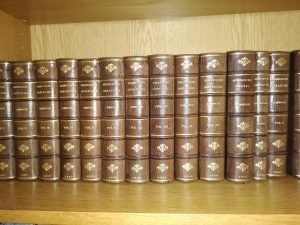 I find maps useful. I own a fabulous Peninsular War Atlas, which is marvellous for all the major battles but I also need to be able to trace the routes my characters take when marching. A lot of the diaries and letters published are great for this, particularly Wellington’s correspondence, since you can see where headquarters was situated on the march by the headings of his letters. I have a beautiful set of his correspondence which my husband bought me for our 25th wedding anniversary and I use them all the time, they’re the joy of my life.
I find maps useful. I own a fabulous Peninsular War Atlas, which is marvellous for all the major battles but I also need to be able to trace the routes my characters take when marching. A lot of the diaries and letters published are great for this, particularly Wellington’s correspondence, since you can see where headquarters was situated on the march by the headings of his letters. I have a beautiful set of his correspondence which my husband bought me for our 25th wedding anniversary and I use them all the time, they’re the joy of my life.
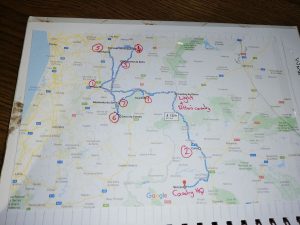 To keep track of where we are, I use Google maps to trace what I know of the routes taken. Most of this is done online as I go along, but occasionally it’s useful to have hard copy to keep referring back to. For example, I’ve printed out a couple of maps and put them in my notebook for book six, showing the location of Wellington’s various divisions through winter quarters. It’s a quick and easy reference tool and stops me making stupid mistakes, such as sending Colonel van Daan to visit the fifth division for a couple of hours when it would actually have taken him a couple of days to get there.
To keep track of where we are, I use Google maps to trace what I know of the routes taken. Most of this is done online as I go along, but occasionally it’s useful to have hard copy to keep referring back to. For example, I’ve printed out a couple of maps and put them in my notebook for book six, showing the location of Wellington’s various divisions through winter quarters. It’s a quick and easy reference tool and stops me making stupid mistakes, such as sending Colonel van Daan to visit the fifth division for a couple of hours when it would actually have taken him a couple of days to get there.
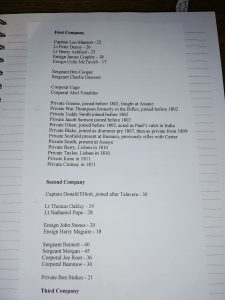 I also keep handy lists in the notebook. At the beginning of each book, I make a new list of my fictional brigade, by battalion and company, and include most of the officers and any significant NCOs and privates. This is a simple word document, which I update when I start a new book, removing anybody who has died, noting promotions and transfers. I then print it out and stick it in the notebook for easy reference. Other lists are specific to each book; I’ve compiled one of Wellington’s staff at HQ since that’s important for this book.
I also keep handy lists in the notebook. At the beginning of each book, I make a new list of my fictional brigade, by battalion and company, and include most of the officers and any significant NCOs and privates. This is a simple word document, which I update when I start a new book, removing anybody who has died, noting promotions and transfers. I then print it out and stick it in the notebook for easy reference. Other lists are specific to each book; I’ve compiled one of Wellington’s staff at HQ since that’s important for this book.
My notebook probably looks chaotic to anybody else, but it’s the basic tool that I work with every day. I started using this method for book four and I love it. I don’t throw the notebooks away when the book is finished, so I have a collection of them now, and they’re quite fun to look through to see how the book developed as I was writing it. More importantly, it stops me writing quick notes on scraps of paper which I then lose. Anything that I need to write down while writing this book goes in that notebook.
Sticky Notes and tags
When I’m first reading up about a campaign, I use a lot of sticky notes and tags to mark pages or sections that are particularly useful. As with notebooks, I much prefer cute tags to plain yellow post it notes, and Sir Charles Oman is currently sporting a fine collection of sea bird tags and Me to You bear post it notes. I’ve got some llama ones that I really like as well. It’s best to be an adult about these things. I don’t make a lot of notes from books, I simply keep the books to hand and refer to them directly as I’m writing.
The End
There’s a magical feeling when the last word is typed, the last edit is done, and the book is finally out there for people to read. One of the great things about writing a series, or even two, is that people are waiting for the books, particularly the Peninsula ones. It can also feel a bit sad. For months, occasionally as long as a year, I’ve lived with these people in my heads every day and now they belong to somebody else. I’ve no control over what people will think of them. Some people will love them, a few won’t, and will say so very vocally in reviews.
There’s a little ritual that I go through once the book is published, clearing my desk. I remove all the tags from the books and put them back on the shelves, I do a final backup of my computer files to make sure and I close my notebook and put it on the shelf with the previous ones. The desk looks empty and very tidy, usually for about twenty-four hours.
Then I get a new notebook out. I always have a stash, I can’t stop buying pretty notebooks. I write the title of the next book on the cover and I put it on my desk. I sit down at my computer and open a new Scrivener file.
And it all begins again.
I hope that “Organised Chaos” gives a little insight into how I work, and answers my reader’s question. I’d be interested to hear how other writers go about organising their work.

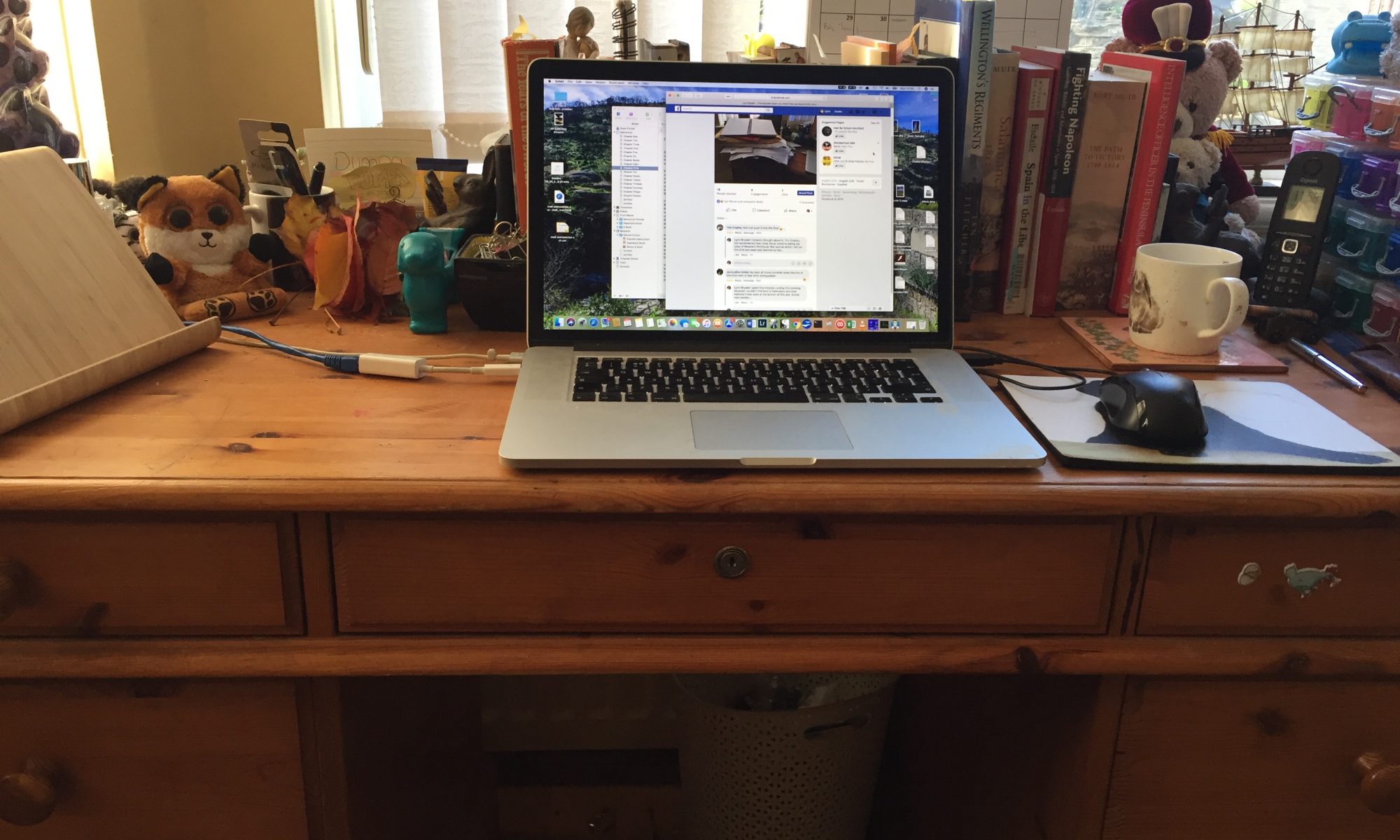
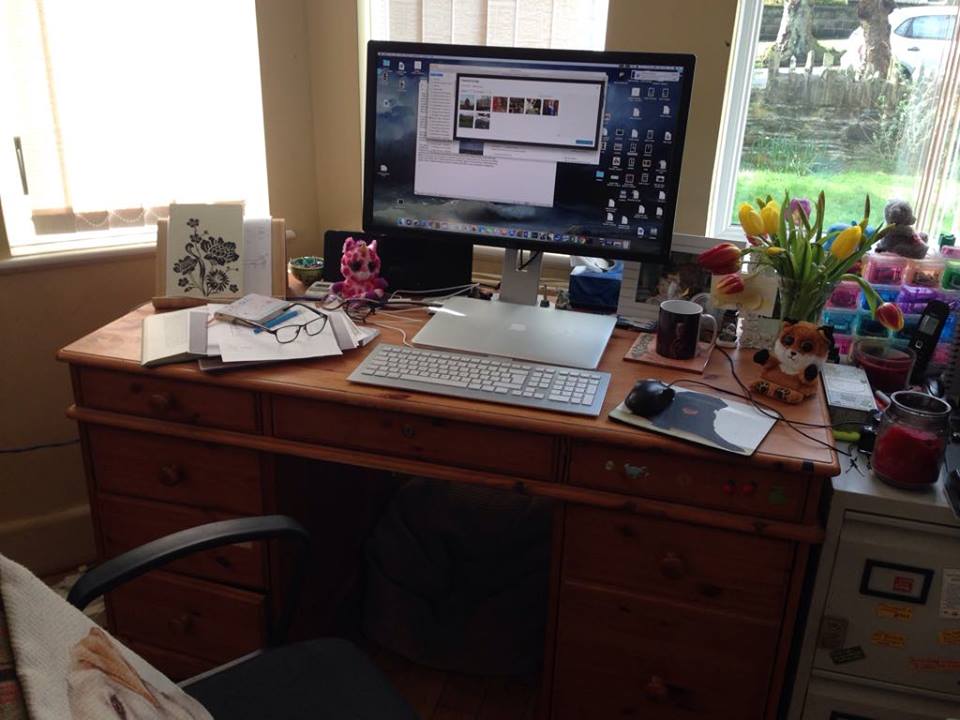
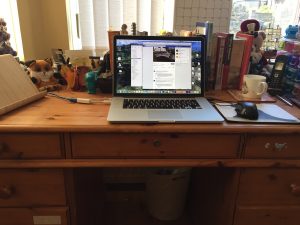 about the writing process from other authors, but I’d rather come to the conclusion that I’m not particularly introspective when it comes to my own work. I love what I do, but I don’t spend a lot of time analysing it and I dread the interview question “what made you become a writer?”. The best answer I could give to that is “I couldn’t help it.”
about the writing process from other authors, but I’d rather come to the conclusion that I’m not particularly introspective when it comes to my own work. I love what I do, but I don’t spend a lot of time analysing it and I dread the interview question “what made you become a writer?”. The best answer I could give to that is “I couldn’t help it.”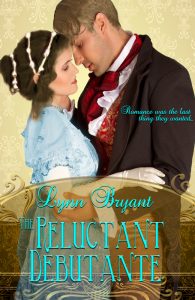 In order to teach something, you have to be able to break it down and I’ve found it easier to do this, as I’ve recently been working on revising one of my earliest books.
In order to teach something, you have to be able to break it down and I’ve found it easier to do this, as I’ve recently been working on revising one of my earliest books.